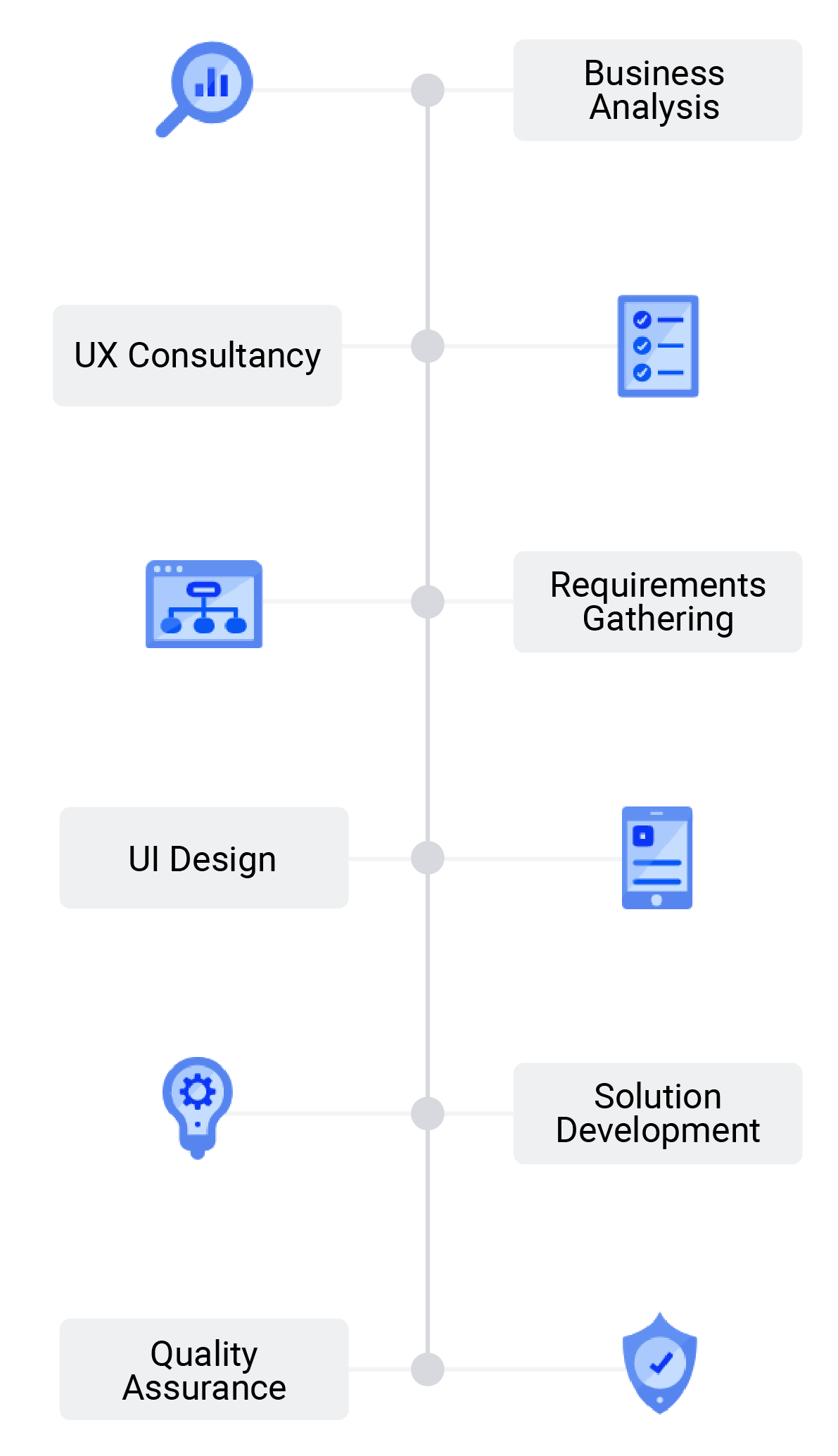UI/UX & BA Collaboration: How It Works at Newfire

An effective partnership between a business analyst (BA) and UI/UX designer can undeniably translate into considerable advances in product development. The collaboration between these key players’ is known to foster collective success for teams and business partners alike. Here, we’ll provide some effective tips and tricks to help your teams improve their efficiency, but we’ll also take a deeper dive into real-life examples from the field. Read on for our “inside scoop” on the special relationship between BAs & UX/UIs here at Newfire.
UI/UX & Business Analyst 2022 Outlook
With “over 174,727 business analysts/quality analysts currently employed in the United States” and a U.S. Bureau of Labor Statistics (BLS) projection of a 25% increase in this sector by 2030, business analysts (BAs) currently have the upper hand when it comes to choosing their place of employment. At Newfire Global Partners, our team of business analysts is so key to our business, they are making a direct impact on patients’ lives across digital health.
On the UI/UX design front, recent news claims that “The demand for the role is steadily increasing. LinkedIn even ranked UX design as one of the top 5 in demand skills as of 2020, while Glassdoor added it to their list of best 50 jobs to have in 2022.”
But what’s adding escalating value to these positions? And why is the collaboration between a UI/UX designer and a business analyst paving the road for business success?
UI/UX & BA Job Descriptions
For those who may be unfamiliar with the specific duties, we’ll start by providing brief overviews for these two key roles.
A UI/UX designer focuses on creating greater user experiences while upholding a business’ specific requirements. Tackling the interface aspect of a user relation, UI/UX professionals can determine and improve product usage and navigation.
As we know, deep expertise in UI/UX design and modern frontend technologies ensure web solutions that can handle complex business requirements. Ultimately, we’re seeking products and platforms that remain intuitive for end users.

Common UI/UX duties generally involve the following:
User Research → User Personas → Visual References → Visual Design → Features Identification → Wireframes → Prototyping → Product Testing
A BA, on the other hand, typically acts as a key liaison between a business partner and a team of designers or developers. A BA’s main objective is to bridge client needs with the development team to ensure value in a company’s product deliveries. To accomplish these tasks, BAs must be able to both comprehend and translate user needs and potential challenges.
Related read: Newfire Global Partners’ BA specialist becomes chapter lead.
While BAs typically account for stakeholder management throughout an entire business process, their common duties typically flow along this path:
Market Analysis → Product Strategy → Product Roadmap → Features Prioritization → Requirements Elicitation → Stakeholder Management → MVP → Success Metrics
This is why we call BAs “jacks of all trades.” They manage, develop, monitor, ensure, measure, coordinate, test, improve, implement, and launch projects. And they do so while keeping various project and business needs in check, team members informed, and (for the most part) everyone happy.
The Heart of the BA & UI/UX Collaboration
The main goal of the BA & UI/UX collaboration is to remain actively involved in a project by working horizontally towards a common business objective and to minimize misunderstandings. These roles should work in unison, creating and demonstrating the holistic team vision and serving as the “owners” of the product development project’s big picture outcomes. That becomes increasingly meaningful when various stakeholders are involved in any given project.
It’s crucial for BAs to work closely with product owners to define a high-level roadmap and prioritization in a Scrum methodology and then move ahead to validate the strategy product requirements with the stakeholders. Ultimately, it’s the BA’s job to ensure features are aligned with business goals to meet users’ expectations.
BA & UI/UX collaboration fosters the perfect balance to properly bridge business partners with product development.
Without this collaboration, a product could easily have great user experience findings but lack requirement validation. A great application or website might never fully evolve into a successful business or a functional product could end up being too hard to navigate and therefore, not user-friendly. At the least, it can simply be excruciatingly time-consuming for designers and developers to service clients. BAs serve as an intermediary between client and design to accelerate the path to launching a product or business.
How It Works at Newfire
Here at Newfire Global Partners, we have a specific set of tips and tricks meant to enhance the daily BA & UI/UX collaboration.
Our BAs act as a bridge between business partners and our development teams. They check on business requirements to create items and user stories for our developers, as well as help with documentation. Between these two steps, BAs engage in sub-steps. First, they determine a client’s needs or desires and document what they map out with clients using Confluence or a similar platform. From there, they discuss this information with the development team, and the data they present has already been groomed, estimated, and prioritized in the backlog. They take it into a sprint and then develop tickets that need to be verified or validated.
In short, BAs take business partner requirements and break them down to create stories via an Agile approach, for instance. This is done so developers can work on them more easily.
One of our UI/UX designers, Ostap, encapsulates the difference between an experienced BA and a project manager: “What a BA in a full time position does with their set of skills is simply not something a project manager can do in a part-time capacity.”
Personal Journeys Across BA & UI/UX Collaborations
When collaborating with his BA counterpart, Ostap (referenced above), sees added value in how his coworker is able to describe client requests from both a technical and user perspective. For him, the collaborative value rests on the ease and speed with which they’re getting a general idea translated into what the client ultimately wants.
As a UI/UX, Ostap can take information from the BA and then visualize and convert it to share with the client. It’s a matter of the BA speaking “the language that a designer understands. A client may not know how to communicate with a designer,” says Ostap. BAs “break it down, deconstruct it, make it clear.
Depending on a particular project, we create a team of BAs and UI/UXs that fits with the project’s needs. For example, we may create a team comprised of a BA working with developers, testers, quality assurance (QA) specialists, and UI/UX designers. To keep communication clear and open between parties, we hold monthly and quarterly meetings.
So, what do we recommend for maintaining an effective BA & UI/UX relationship?
#1 Set an intention
Aim to make this working relationship a valuable bridge that’s valuable and productive for both parties.
#2 Show up
Make it to the meetings, reply to the emails, respond to the other person’s Slack messages.
#3 Keep an open dialogue
In other words, prioritize open and transparent communication.
#4 Solicit advice
While focusing on your specific project, feel free to reach out to fellow colleagues who might have tips, tricks and advice to share. There’s a lot to learn from others, particularly on how they may face their own unique challenges.
#5 Don’t recreate the wheel
Heard about a new way to huddle that’s been helping other teams make advances? Give it a try! Know of a related team who overcame a setback in a particular technical or social way? Steal the process! Follow the lead from others who may have been in your place before. Save some time, effort, and energy.
Putting it all together
It’s one thing to see these ideas listed out, but we believe it really “sinks in” with a testimonial from the real world. Check out what Ostap has to say about his day-to-day collaborative work as a UI/UX designer here at Newfire:
“Newfire offers a very flexible, healthy work environment for creating positive collaboration between BAs and UI/UX designers. As a team, we work together to create a work process based on popular and effective frameworks with room for adjustment based on the unique needs of the client and the development team. After fine-tuning the framework, the BA and UI/UX designer generally set up a work routine that takes into account the peculiarities of each given sphere. Ideally, this communication plan lasts throughout the duration of the project, forming a healthy bond around client requirements, user research, development specifics, user interface, and design.”
The True Value of Working at Newfire Global Partners
Here at Newfire, the most valuable part of our work is knowing we’re making an impact on some of the world’s toughest problems. For example, helping with the creation of a marketplace platform that connects therapists services with patients. This is done using best-in-class technology to collect and interpret data in order to optimize therapy sessions and help patients achieve their potential in all aspects of their lives. Other examples include creating a customized notification system for patients on various medications or developing meaningful tools for LGBTQIA+ folks undergoing gender transition.
These professionals are part of a worldwide network that allows them to foster their technological knowledge and skills. Their internal and external communities are always active, seeking to apply the best knowledge in the industry to continue making great strides in digital health.
While BAs, QAs, and project managers often work independently, one thing we hear a lot from our team members is how much they appreciate getting to be the owners of their own domains while being an active part of a team that thrives on feedback and communication to improve their development.
What about you? Are you currently working on intellectually stimulating projects with great teammates and clients of your choosing? Click here to learn more about our open positions.